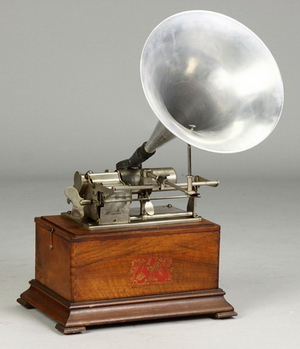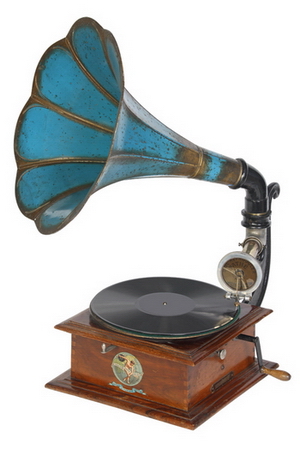|
Pathé: "I Sing Loud and Clear"
by Darren Wallace
After the "big three" - Edison, Columbia and Victor -
Pathé is the most important name in the development
of
the
phonograph
or
gramophone
and
of
sound
recordings
on either
cylinder or disc.
Charles Pathé's interest
in the phonograph was roused
in August 1894 while visiting a fair in Vineenes.
He
was
fascinated
by an Edison phonograph
on
display
and
watched as
20 or
so people listened
to it with
tubes
to
their
ears.
Each
had
paid
2
francs
"per
performance"
and it was
soon
evident
to Pathé that
there was
money
to be made in this
new
invention.
He
quit his job and went about raising the necessary
capital
to
buy
a
machine:
1,000
francs
for
the
phonograph and 800 francs for the cylinders.
In September 1894 Pathé set up his first
booth at a
fair just
outside
of Paris.
It brought
in
200 francs
and soon the young entrepreneur was turning a profit.
Unable
to keep up
with
public
demand,
he
started
selling
phonographs
and
cylinders.
And
to keep his
customers
coming
back
for
more
he
manufactured
cylinders
at
his
home,
recording
popular
opera
singers
and
vaudeville
artists
of
the
day.
Pathé
further increased sales by offering credit.
Charles Pathé and his brother, Emile,
established the
Original
Pathé
Frères
Company
in
1896.
In
the
beginning,
Pathé offered
phonographs
imported
from
America:
the
Columbia
Graphophone
in
the
lower
price
range, Edison's for people willing
to pay
more
for
quality.
When the company
expanded enough
to
start
manufacturing
its own machines
they
produced
one that was almost identical
to the Columbia "Eagle",
the
"Le
Coq".
The
first
Pathé
machines
lacked
originality
in design but gradually
took on the "European
look"
that
is
typical
throughout
other
lesser
known
manufacturers.
The company's
slogan was
"Je chant haut et clair" - "I sing loud and clear". Pathé
was soon a market leader in France and neighbouring
countries.
The Pathé Machines
Pathé's first
"range"
of five machines were
identified
by
numbers:
the smallest being "No.
0",
the largest
"No. 4".
The only difference between them was their
motor size and cabinet style. Phonographs
"No. 0" to
"No.
3"
played
both
standard
and
Salon
cylinders,
"No.
4"
played
these
and
the
5
inch
concert
cylinders.
All
cabinets
were
made
of walnut
except
"No.
0"
which
was
of
oak.
The
interesting
thing
about all of these machines
is they all use the same
horn
and
black
ebonite
composition
reproducer;
a
"No. 0" did not sound any better than a "No. 4"! The
latter just
looked
better.
Pathé offered a wide range
of
horns,
however,
made
from
either
sheet
metal,
cardboard,
brass or aluminum, and even glass.
Pathéphone modèle F

|
|
Most
machines
incorporated
the
same principles
of
the
"Puck"
machine
where
the
reproducer
is
connected
right onto the horn. The horn is critically
balanced
and
the
reproducer
sits
on
top
of
the
cylinder.
Pathé
went one step further than this by
taking the horn assembly and attaching it to a metal
rod frame that is
moved with a feedscrew. They also
have a spring clip that holds the horn and stylus in
a
non-playing
position
to
facilitate
record
changes.
The entire
attachment
was
known
as
the
"Orpheus
attachment"
or
"Vérité
system".
When
this
was
introduced
it was realized that it could be bought as
a separate unit and used in the early
"Columbia"
and
"Edison"
type Pathé machines.
The
first
disc
machines
were
known as
the
model
"A",
followed by the
model
"B".
They
used
a ball-shaped
sapphire
stylus and the reproducers for these
machines
were
used
on virtually all the
company's
machines,
unchanged in design until
about
1915-18.
The
model
"A"
machine
was
the
only
front-mount
disc machine
made by Pathé.
The first
concealed
horn machine was
introduced
in
1910. It was actually the open-horned model
"B" in a
gigantic
cabinet
with
the
mouth
of the
horn
being
exposed to the outside of the case. The company
also
came
up
with
a
bizarre
machine
that
had
two
separate
tone arms and
reproducers
which played the
record
at
the
same
time.
This gives an
interesting
effect when the styli are not in sync.
All
Pathé machines can easily
be recognized by the
company's
trademark
- a
rooster
listening
to
a
phonograph.
The
only
machines
that
did
not
carry
this
were
those
sold
on
credit.
These
models
had
their own
names:
"Le charte
claire",
"Le Menestral",
etc.
They
were
basically
Pathé machines
with
a
lot
more
ornamentation
on
the
cases
but
no
manufacturer's
name.
Pathé phonograph Coq modèle 1

|
|
Pathé cylinders and discs
Pathé
was
one
of
the
pioneers
in
the
cylinder
molding process and also the only company
to ever
mould
in
wax
cylinders
larger
than
standard.
The
company
produced
four
different
sizes:
the
standard
cylinder,
5"
concert
cylinders,
its
own
"Salon"
cylinder which was
approximately
3 1/4"
in diameter,
and
the
8"
long
"Le
Celeste".
The
"Le
Celeste"
cylinders are extremely rare today, the machines that
played
them
more
so; only one was made.
In
1906
Pathé
entered
the disc market.
These were
recorded
by the hill-and-dale
method and
transferred
from
cylinders.
They
play beginning at the centre of
the disc rather than the outside
edge. This was done
because the peripheral speed of any disc slows as the
needle gets to the centre of the record.
Because most
music reaches its climax at its end and, therefore, at
the point on the disc when sound quality
may
begin
to
deteriorate,
reversing
the
starting
point,
it
was
thought, would correct this.
Pathé discs were
made available
in 8", 10",
14" and
20"
sizes.
All had the
same
length of playing time.
Because of the problem
of size with the large discs
most
Pathé
machines
have an ingenious
instant start
lever
on the front
of the case which,
when
pulled,
instantly
brought
the
turntable
up
to
90 rpm,
the
speed used on all the company's early discs.
The
early
discs
did
not
use
paper
labels.
The
information
was
engraved
into
the
surface
and
the
etched
lettering,
etc.,
filled
with
paint
to make the
words legible. Paper labels were introduced
in about
1908.
Pathé
abandoned
the hill-and-dale
records
in
1929
and
from then on produced needle cut records
under
the
name "Actuelle".
Not long after this the company
was taken over
by Marconi
to
become
Société
Pathé
Marconi.
This
enterprise
was
later
bought
by
the
Gramophone
Company
and
Columbia
to
become
the
EMI Corporation.
|